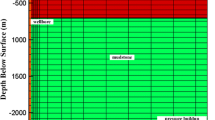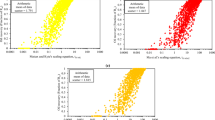Abstract
Deep brine recovery enhanced by supercritical CO2 injection is proposed to be a win–win method for the enhancement of brine production and CO2 storage capacity and security. However, the cross-flow through interlayers under different permeability conditions is not well investigated for a multi-layer aquifer system. In this work, a multi-layer aquifer system with different permeability conditions was built up to quantify the brine production yield and the leakage risk under both schemes of pure brine recovery and enhanced by supercritical CO2. Numerical simulation results show that the permeability conditions of the interlayers have a significant effect on the brine production and the leakage risk as well as the regional pressure. Brine recovery enhanced by supercritical CO2 injection can improve the brine production yield by a factor of 2–3.5 compared to the pure brine recovery. For the pure brine recovery, strong cross-flow through interlayers occurs due to the drastic and extensive pressure drop, even for the relative low permeability (k = 10−20 m2) mudstone interlayers. Brine recovery enhanced by supercritical CO2 can successfully manage the regional pressure and decrease the leakage risk, even for the relative high permeability (k = 10−17 m2) mudstone interlayers. In addition, since the leakage of brine mainly occurs in the early stage of brine production, it is possible to minimize the leakage risk by gradually decreasing the brine production pressure at the early stage. Since the leakage of CO2 occurs in the whole production period and is significantly influenced by the buoyancy force, it may be more effective by adopting horizontal wells and optimizing well placement to reduce the CO2 leakage risk.









Similar content being viewed by others
References
Amini H, Alvarez E, Wilkinson D, Lorsong J, Slater J, Holman G, Timofeeva O (2014) 4D seismic feasibility study for enhanced oil recovery (eor) with CO2 injection in a mature North Sea field. In: Fourth EAGE CO2 Geological Storage Workshop
Bergmo PE, Grimstad A-A, Lindeberg E (2011) Simultaneous CO2 injection and water production to optimize aquifer storage capacity. Int J Greenh Gas Control 5:555–564. doi:10.1016/j.ijggc.2010.09.002
Birkholzer JT, Zhou Q, Tsang C-F (2009) Large-scale impact of CO2 storage in deep saline aquifers: a sensitivity study on pressure response in stratified systems. Int J Greenh Gas Control 3:181–194. doi:10.1016/j.ijggc.2008.08.002
Birkholzer JT, Cihan A, Zhou Q (2012) Impact-driven pressure management via targeted brine extraction: conceptual studies of CO2 storage in saline formations. Int J Greenh Gas Control 7:168–180. doi:10.1016/j.ijggc.2012.01.001
Buscheck TA, Sun Y, Chen M, Hao Y, Wolery TJ, Bourcier WL, Court B, Celia MA, Friedmann SJ, Aines RD (2012) Active CO2 reservoir management for carbon storage: analysis of operational strategies to relieve pressure buildup and improve injectivity. Int J Greenh Gas Control 6:230–245. doi:10.1016/j.ijggc.2011.11.007
Connell LD, Pan Z, Meng S, Camilleri M, Down D, Carras J, Zhang W, Fu X, Guo B, Briggs C, Lupton N (2013) Description of a CO2 enhanced coal bed methane field trial using a multi-lateral horizontal well. Int J Greenh Gas Control 37(7):6760–6768
Court B, Bandilla KW, Celia MA, Buscheck TA, Nordbotten JM, Dobossy M, Janzen A (2012) Initial evaluation of advantageous synergies associated with simultaneous brine production and CO2 geological sequestration. Int J Greenh Gas Control 8:90–100. doi:10.1016/j.jjggc.2011.12.009
Fang Q, Li Y (2014) Exhaustive brine production and complete CO2 storage in Jianghan Basin of China. Environ Earth Sci 72(5):1541–1553
Fang Q, Li Y, Lv J, Cheng P (2016a) Estimation on production efficiency and leakage risk of pure large-scale exploitation of deep brine. Saf Environ Eng 23(3):113–118 (in Chinese with English abstract)
Fang Q, Lv J, Peng G (2016b) Numerical simulation on the effect of generalized model of sandstone and mudstone interlayers on CO2 geological storage. J Univ of South China (Sci Technol) 30(4):16–20 (in Chinese with English abstract)
Fei WB, Li Q, Wei XC, Song RR, Jing M, Li XC (2015) Interaction analysis for CO2 geological storage and underground coal mining in Ordos Basin, China. Eng Geol 196:194–209
Fujioka M, Yamaguchi S, Nako M (2010) CO2-ECBM field tests in the Ishikari Coal Basin of Japan. Int J Coal Geol 82(3):287–298
Gale J (2004) Geological storage of CO2: what we know, where are the gaps, and what more needs to be done. Energy Convers Manag 29(9–10):1329–1338
Garapati N, Randolph JB, Saar MO (2015) Brine displacement by CO2, energy extraction rates, and lifespan of a CO2-limited CO2-plume geothermal (CPG) system with a horizontal production well. Geothermics 55:182–194
Goda T, Sato K (2013) Global optimization of injection well placement toward higher safety of CO2 geological storage. Energy Procedia 37:4583–4590
Gou Y, Hou Z, Liu H, Zhou L, Were P (2014) Numerical simulation of carbon dioxide injection for enhanced gas recovery (CO2-EGR) in Altmark natural gas field. Acta Geotech 9(1):49–58
Holloway S (2005) Underground sequestration of carbon dioxide—a viable greenhouse gas mitigation option. Energy 30:2318–2333
Hou Z, Gou Y, Taron J, Gorke UJ, Kolditz O (2012) Thermo-hydro-mechanical modeling of carbon dioxide injection for enhanced gas-recovery (CO2-EGR): a benchmarking study for code comparison. Environ Earth Sci 67(2):549–561
IPCC (2007) Climate change 2007: the physical basis, the fourth estimation report of the intergovernmental panel on climate change, summary for policymakers, http://www.ipcc.ch
Jiao ZS, Zhou LF, Gao RM, Luo TT, Wang H, Heng Y, McLaughlin F, Bentley R, Quillinan S (2014) Opportunity and challenges of integrated enhanced oil recovery using CO2 flooding with geological CO2 storage in the ordos Basin, China. Energy Proced 63:7761–7771
Kühn M, Görke U-J, Birkholzer JT, Kolditz O (2012) The CLEAN project in the context of CO2 storage and enhanced gas recovery. Environ Earth Sci 67:307–310
Li Y, Fang Q, Ke Y, Dong J, Yang G, Ma X (2012) Effect of high salinity on CO2 geological storage: a case study of Qianjiang Depression in Jianghan Basin. Earth Science. J China Univ Geosci 37(2):283–288 (in Chinese with English abstract)
Li Q, Fei W, Liu X, Wei X, Jing M, Li X (2014) Challenging combination of CO2 geological storage and coal mining in the Ordos basin. China. Greenh Gases: Sci. Technol. 4(4):452–467
Pan Y, Liu C, Xu H (2011) Characteristics and formation of potassium-bearing brine in the deeper strata in Jiangling Depression in Hubei Province. Geol Chem Miner 33(2):65–72 (in Chinese with English abstract)
Pruess K, Spycher N (2007) ECO2 N—a fluid property module for the TOUGH2 code for studies of CO2 storage in saline aquifers. Energy Convers Manage 48:1761–1767. doi:10.1016/j.enconman.2007.01.016
Yamamoto HY, Zhang K, Karasaki K, Marui A, Uehara H, Nishikawa N (2009) Numerical investigation concerning the impact of CO2 geologic storage on regional groundwater flow. Int J Greenh Gas Control 3:586–599. doi:10.1016/j.ijggc.2009.04.007
Zhang K, Wu Y-S, Pruess K (2008) User’s Guide for TOUGH2-MP—a massively parallel version of the TOUGH2 Code. Report LBNL-315E. Lawrence Berkeley National Laboratory, Berkeley, CA, USA
Acknowledgements
This wok was supported by National Science Foundation of China (No. 11545016), the Foundation of Education Department of Hunan Province (16C1372) and Science and Technology Bureau of Hengyang City (2015KS05) as well as Doctoral Scientific Fund of University of South China (2014XQD12). We would like to thank the anonymous reviewers for their constructive comments and suggestions on this manuscript.
Author information
Authors and Affiliations
Corresponding author
Rights and permissions
About this article
Cite this article
Fang, Q., Lv, J., Peng, G. et al. Numerical simulation to quantify the leakage risk in a multi-layer aquifer system of pure brine recovery and CO2-enhanced brine recovery: a case study of potassium-rich brine recovery in Jianghan Basin of China. Environ Earth Sci 76, 464 (2017). https://doi.org/10.1007/s12665-017-6782-7
Received:
Accepted:
Published:
DOI: https://doi.org/10.1007/s12665-017-6782-7




